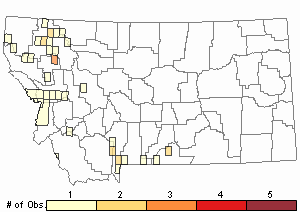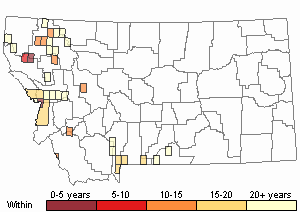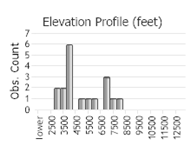View in other NatureServe Network Field Guides
NatureServe
Montana
Utah
Wyoming
Idaho
Wisconsin
British Columbia
South Carolina
Yukon
California
New York
A Liverwort - Marchantia polymorpha
General Description
Plants: Thallose, up to 5 x 2 cm. Long slender air chambers on dorsal surface form hexagonal or diamond-shaped patterns perceptible to the unaided eye (Bland 1971); a “chimney-like pore” opens into each chamber (Bland 1971, Nicholson 1966, Schofield 2002); this opening may appear as a dot in the center of each (hand lens helpful). Rhizoids abundant (Bland 1971, Schofield 2002), cottony; those perpendicular to thallus attach it to the substrate while others run parallel to the thallus surface. Scales on ventral surface, often purple-tinted, are most apparent near lobe ends.
Sex Organs: Specialized branches grow perpendicularly to the thallus, ending in a disc-shaped receptacle, which may develop archegonia or antheridia (Schofield 1985). Archegonia-bearing receptacles transform to radiate long lobes or spokes (become umbrella-shaped) (Schofield 1985), and are light green when young, turning yellowish brown with age; antheridia-bearing receptacles are often tinted with purple (Schofield 2002). (A female receptacle along with elongated stalk is called an archegoniophore. A male receptacle with its stalk is an antheridiophore) (Schofield 1985). In the photo showing archegoniophores above, two antheridiophores are on the left side, just above the middle.
In Marchantia, moisture triggers the opening of antheridia. Splashing raindrops may transport sperm to the spokes of the female receptacle and to the eggs (Nicholson 1966). Following fertilization, the seta grows, elevating the female receptacle with sporophyte above the thallus (Bland 1971), where air currents disseminate the spores.
Diagnostic Characteristics
The umbrella-shaped female receptacles are distinctive, as is a commonly seen dark stripe running centrally the length of the thallus. Marchantia differs from Lunularia as the latter has crescent-shaped rather than Marchantia’s round gemma cups, and short air chambers as viewed at the surface rather than long narrow ones (Schofield 2002).
Observations in Montana Natural Heritage Program Database
Number of Observations: 42
(Click on the following maps and charts to see full sized version)
Map Help and Descriptions
Relative Density

Recency



 (Observations spanning multiple months or years are excluded from time charts)
(Observations spanning multiple months or years are excluded from time charts)
Habitat
Wet, shaded areas, such as along watercourse banks, seeps, marshy areas, gardens and plant nurseries; damp ashes in burned areas (Bland 1971, Nicholson 1966, Schofield 2002).
Reproductive Characteristics
Receptacles emerge in spring (Schofield 2002). Sporophytes are fully developed in summer or fall.
Vegetative Reproduction: Provided by gemmae and fragmentation. Gemma cups, round in outline with serrate margins, form most often in spring and fall. Splashing water disperses the gemmae, which may then produce new rosettes (Nicholson 1966, Schofield 1985). Fragmentation occurs when a branch dies at the base of a fork, producing two entities (Bland 1971, Schofield 1985).
Management
Often colonizes burned areas a couple of years after the fire. May become a greenhouse or garden weed from splashing water distributing the gemmae (Schofield 1985, 2002).
References
- Literature Cited AboveLegend:
 View Online Publication
View Online Publication Bland, J.H. 1971. Forests of Lilliput: The Realm of Mosses and Lichens. Englewood Cliffs, NJ: Prentice-Hall. 210 p.
Bland, J.H. 1971. Forests of Lilliput: The Realm of Mosses and Lichens. Englewood Cliffs, NJ: Prentice-Hall. 210 p. Nicholson, B.E. and F.H. Brightman. 1966. The Oxford Book of Flowerless Plants: Ferns, Fungi, Mosses and Liverworts, Lichens, and Seaweeds. London: Oxford University Press. 208 p.
Nicholson, B.E. and F.H. Brightman. 1966. The Oxford Book of Flowerless Plants: Ferns, Fungi, Mosses and Liverworts, Lichens, and Seaweeds. London: Oxford University Press. 208 p. Schofield, W.B. 1985. Introduction to Bryology. Caldwell, NJ: Blackburn Press. 434 p.
Schofield, W.B. 1985. Introduction to Bryology. Caldwell, NJ: Blackburn Press. 434 p. Schofield, W.B., P. Drukker-Brammall, and M. Pacheco. 2002. Field Guide to Liverwort Genera of Pacific North America. Banff, AB: Global Forest Society in association with University of Washington Press. 228 p.
Schofield, W.B., P. Drukker-Brammall, and M. Pacheco. 2002. Field Guide to Liverwort Genera of Pacific North America. Banff, AB: Global Forest Society in association with University of Washington Press. 228 p.
- Additional ReferencesLegend:
 View Online Publication
View Online Publication
Do you know of a citation we're missing? Elliot, J. C. 1993. Second checklist of Montana mosses. Unpublished report. U.S. Forest Service, Region 1. Missoula, MT. 45 pp.
Elliot, J. C. 1993. Second checklist of Montana mosses. Unpublished report. U.S. Forest Service, Region 1. Missoula, MT. 45 pp.
- Web Search Engines for Articles on "A Liverwort"





